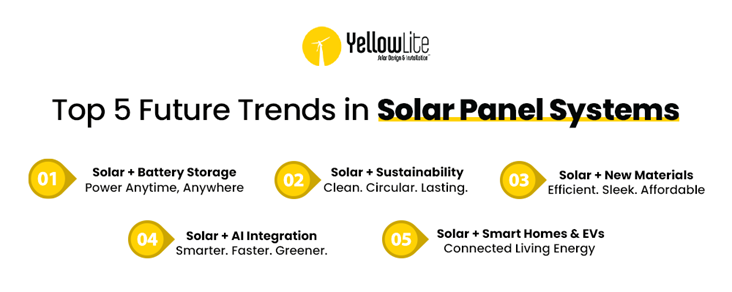When it comes to clean energy, the solar panel system is no longer just about lowering bills; it’s about powering the future. What once felt futuristic is now reality: smarter panels, AI-driven inverters, energy-sharing microgrids, and storage that keeps homes and businesses running 24/7.
At YellowLite, we’ve seen firsthand how rooftops are turning into energy hubs and how communities are preparing to run on solar-powered grids. The question is no longer if solar will define the future; it’s how fast. Let’s explore the advancements shaping tomorrow’s energy landscape.
What Is a Modern Solar Panel System and How Does It Work?
A solar panel system is made up of solar panels, inverters, and sometimes batteries, working together to capture sunlight and turn it into usable power.
- Panels convert sunlight into direct current (DC).
- An inverter changes DC into alternating current (AC), which powers your home or business.
- Excess electricity can be stored in a battery or exported back to the utility grid.
This smart flow of energy means that your rooftop is not just saving you money, it’s contributing clean power to your community.
Solar Panel System and the Grid: Powering Homes and Businesses
The beauty of solar is how seamlessly it integrates with the grid. With net metering, homeowners and businesses can return unused energy to the grid, earning credits that lower utility bills.
Whether a small home or a large commercial building, a solar panel system helps reduce reliance on fossil fuels while providing stable, predictable energy costs.
Solar + Storage: The Rise of Energy Independence
Pairing a solar panel system with advanced battery storage is becoming the gold standard. In the coming years, batteries will become cheaper, more compact, and longer lasting. This means:
- 24/7 solar power, not just during the day.
- True energy independence, even during outages.
- A shift from “grid reliance” to microgrids, where neighborhoods can share stored power.
As storage evolves, solar panel cost will increasingly be measured not only by installation price but also by long-term resilience and backup value.
Smart Solar Panel Systems and AI Integration
The next generation of solar panel systems are smarter, not just stronger. Artificial intelligence (AI) and machine learning are being built into solar inverters and monitoring tools. These systems can:
- Predict energy usage patterns in your home.
- Automatically adjust power flows to maximize efficiency.
- Integrate seamlessly with smart appliances and electric vehicles.
Think of it as your energy system learning how you live and optimizing your savings automatically.
Solar Panel Systems and Sustainability: A Greener Tomorrow
The benefits of a solar panel system go far beyond financial savings. Every installation plays a direct role in creating a cleaner, more sustainable future. Traditional electricity generation relies heavily on fossil fuels, releasing tons of carbon dioxide and other pollutants into the atmosphere. By contrast, solar produces clean energy with zero emissions during operation.
Here’s what sustainability looks like with solar:
- Carbon Reduction – A typical residential solar panel system offsets 3–4 tons of CO₂ each year, the equivalent of planting over 100 trees annually.
- Cleaner Air and Water – Solar doesn’t burn fuel or require large amounts of water for cooling, unlike coal or natural gas plants.
- Circular Economy Potential – Modern panels are increasingly designed with recyclability in mind, ensuring valuable materials can be reused at the end of their 25–30 year lifespan.
- Future-Ready Communities – As more homes and businesses adopt solar, neighborhoods can transition to low-carbon microgrids, reducing strain on the environment while ensuring energy resilience.
At YellowLite, sustainability isn’t just a side benefit, it’s the core of why we build solar solutions. Every rooftop we transform is a step toward a greener, more independent energy future.
Breaking Down Solar Panel Cost in 2025
A common question homeowners ask is about solar panel cost. The good news is that solar is more affordable than ever.
In 2025, the average cost of a residential solar panel system before incentives ranges from $15,000 to $25,000.
On average, homeowners reach "payback" within 7–10 years. After that, the solar panel system continues producing low-cost energy for decades.
Factors That Influence Solar Panel Cost
Several factors determine your final solar panel cost:
- System Size – More panels = higher upfront cost, but also more savings.
- Roof Type & Condition – Complex installations may add to labor expenses.
- Equipment Quality – Premium panels and inverters cost more but deliver higher efficiency.
- Storage – Adding batteries increases cost but provides backup during outages, and energy even when the sun isn't out.
Top Futuristic Benefits of Installing a Solar Panel System
Switching to a solar panel system isn’t just about today’s savings; it’s about preparing for tomorrow’s energy future. Here’s what modern solar brings to the table:
- Smart Energy Independence – Future-ready systems powered by AI and smart inverters will optimize usage and shield you from unpredictable utility rates.
- Future-Boosted Property Value – Homes with next-gen solar and storage will be more attractive to eco-conscious buyers and communities.
- Next-Level Sustainability – Every installation reduces carbon emissions today while paving the way for cleaner, smarter grids tomorrow.
- Always-On Resilience – With advanced batteries and microgrid integration, solar keeps your home running even when the grid goes dark.
- Compounding Savings – The earlier you invest in solar, the more money it will save you over time.
How a Solar Panel System Saves You Money Long-Term
Unlike traditional electricity bills that rise year after year, a solar panel system locks in predictable energy costs.
Homeowners typically see 60–80% savings on their bills. Businesses, meanwhile, can take advantage of tax incentives and accelerated depreciation, turning solar into a high-ROI investment.
And the savings don’t stop at the present. Future advancements like AI-powered load balancing, real-time energy trading, and vehicle-to-grid (V2G) integration will allow solar-powered homes and businesses to save money and potentially earn money by selling excess power back to the grid or sharing it within community microgrids.
In other words, a solar investment today isn’t just about lowering monthly bills; it’s about building an energy asset that grows in value as utility costs continue to rise.
Future Trends in Solar Panel Systems and Costs

The next wave of solar technology is even brighter. Expect to see:
- Bifacial Panels that capture sunlight from both sides.
- Smart Inverters that improve efficiency and enable real-time monitoring.
- Community Solar Projects allowing shared benefits for neighborhoods.
- Declining Solar Panel Cost as technology advances and adoption scales.
The solar panel system of the future won’t just power homes; it will power entire energy-sharing communities.
FAQs
1. How much can a solar panel system save me on energy bills?
Most homeowners save between 60–80% depending on system size and energy use.
2. What is the average solar panel cost in 2025?
Around $15,000–$25,000 before incentives for residential systems.
3. Do solar panel systems work on cloudy days?
Yes, though output may be lower. Modern panels still generate energy in indirect sunlight.
4. How long does a solar panel system last?
Typically 25–30 years with minimal maintenance.
5. Can I finance my solar panel system?
Yes. Solar loans, leases, and power purchase agreements (PPAs) make solar affordable for nearly every household.




